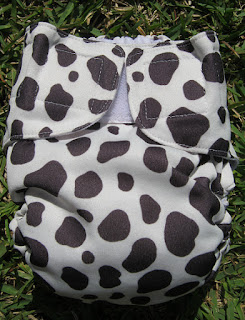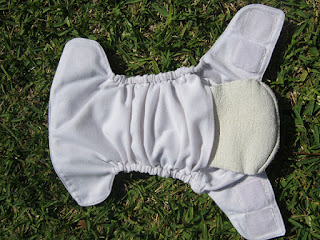2-Piece or Pocket Cloth Nappies
When I was researching cloth nappies more than a year ago, I found a lot of different styles on the market.
I wanted something easy to use, easy to maintain and reasonably priced.
After purchasing and trying some of the brands with the best reputation, I decided I would try to make them myself. My goal was to end up with a trim, well-fitting and comfortable nappy for baby, with a natural fiber fabric next to baby’s skin.
The 2-piece nappy style appealed to me for the reason that I needed only 4-5 shell covers and 15 to 20 soakers/inserts.
I found the Little Green Bear pattern a very good and trim fit. Thank you, LGB, for sharing your great work!
The soakers have two visible layers on the outside and one hidden microfiber layer inside.
The first layer – the back of the soaker - is made from PUL. It is waterproof and keeps the shell cover clean, dry and easy to reuse with each nappy change.
The second layer – it is the thickest, with three layers of very absorbent microfiber attached to two layers of hemp and cotton blend (55% Hemp, 45% Cotton Fleece Knit). Hemp has four times the durability and absorption of cotton and also has anti-bacterial and anti-fungal properties.
The first and second layers are attached fully to one another to prevent the microfiber touching the baby’s skin, which is not recommended. Microfiber is used for it’s good absorbency but can be omitted and replaced with more hemp, cotton or bamboo blend layers.
The third layer is the top, made from two hemp/cotton blend layers. It is not attached fully to the other two to allow the soaker to dry more easily.
Created in this way, there is all natural fiber next to the baby’s skin, which was one of my original goals.
Boosters add absorbency to the soakers/inserts when needed, as nighttime. Boosters can be made out of microfiber, sandwiched between hemp, bamboo, cotton blend natural fiber layers.
Of course, again, microfiber can be omitted and replaced with all natural fibers.
Fitted nappies can be made, using the same pattern, from all natural fabrics. Hidden microfiber can be added for better absorbency or replaced with all natural fabrics, which would make the nappy a little bulkier.
Stay-dry liners can be made from suedecloth which I find more superior than microfleece. I could either sew them fully to the top soaker layer or make them separate.
The covers/pockets are made out of PUL on the outside (the waterproof fabric) and suedecloth or microfleece on the inside. These are all synthetic fabrics but keep the moisture away very well. My baby is not sensitive to them and I have never had any problem using those. They are the most commonly used in nappy making.
I made the covers in a way that they can be used either as covers or pockets. This means I can either put the soaker/insert directly next to baby’s skin and use them only to hold the piece in place, or stuff them with the soaker/insert, using the pocket opening and use them as stay-dry pocket nappies.
The difference between the two methods is that in using them as a 2-piece nappy, you don’t need to change the cover as long as it is not very wet or soiled and could reuse it, changing only the soaker. The PUL backing of the soakers keeps the inside of the covers clean and dry.
When using them as pocket nappies, you will need to change everything each time you change the nappy. This is because the pocket cover will be soiled even if you don’t feel it wet next to your hand. When used in this way you will need more pocket covers, therefore, one for every nappy change.
I sometimes use them as pockets when I decide I want to have the benefit of the stay-dry inside of the pocket cover. It keeps my baby’s skin perfectly dry.
When using them as covers, just lay the soaker piece inside.
The covers have an additional loop piece on the inside of the wings used for closure, so that when washing them their hooks do not stick or catch any other clothing.
Maintenance
The covers and soakers/inserts can be washed with the regular wash, up to 60°C water temperature. Stripping might be necessary, depending on your washing machine. I found that with different washing machines I need more or less stripping.
Covers and stay-dry liners don’t need a lot of drying time and PUL fabrics are usually advised not to be dried in a tumble-dryer as the laminated part of the fabric can be damaged by the high heat.
In my experience, after more than a year of regular use of one cycle in the thumble-dryer, my covers have no damage.
Sizes
Small – newborn to 6kg
Medium – 5kg to 12kg
Large – 9kg to 16kg
Sizes of the soakers/insert will be cut according to the size of the covers.
Colours
Solid or printed, laminated fabrics come not only as the one you see on the photos, but in a Minky or even denim variety.
The possibilities here are endless. By using either just the PUL as a top layer of the cover, or adding another cotton printed fabric layer on top of it, I can create the nappy as unique and special as the baby wearing it.
Whatever your preferences are, I would love to create the best nappy for your baby that both of you will love and enjoy!













I am intreted to nou how did you make this blog. I love your blog.
ReplyDeletefrom: Martin
to: Maria
Cool
Thank you, my sweet boy!
DeleteIt's my first comment from my biggest fan. :-)